

| Region rejsu : Północna Europa, Morze Śródziemne, Europa |
| Firma : MSC Cruises |
| Statek : MSC Magnifica |
| Data rozpoczęcia : wt. 05 maj 2026 |
| Data zakończenia : pt. 15 maj 2026 |
| Liczba nocy : 10 nocy |
| Dzień | Data | Port | Wypłynięcie | Odpłynięcie |
|---|---|---|---|---|
| 1 | 5.05 wt. | Barcelona / Hiszpania | 18:00 | |
| 2 | 6.05 śr. | Dzień na morzu / Morze | ||
| 3 | 7.05 czw. | Malaga / Hiszpania | 07:00 | 17:00 |
| 4 | 8.05 pt. | Casablanka / Morocco | 07:00 | 22:00 |
| 5 | 9.05 sob. | Dzień na morzu / Morze | ||
| 6 | 10.05 niedz. | Dzień na morzu / Morze | ||
| 7 | 11.05 pon. | Bilbao / Hiszpania | 08:00 | 18:00 |
| 8 | 12.05 wt. | La Rochelle / Francja | 07:00 | 16:00 |
| 9 | 13.05 śr. | Dzień na morzu / Morze | ||
| 10 | 14.05 czw. | Dzień na morzu / Morze | ||
| 11 | 15.05 pt. | Kopenhaga / Denmark | 12:00 |
Zakwaterowanie w kabinie wybranej kategorii
Wyżywienie w restauracji (bufecie) w formie „szwedzkiego stołu”, obejmujące śniadanie, obiad i kolację, a także przekąski w kawiarni i pizzerii przez cały dzień. Woda, soki, herbata i kawa z automatów dostępne w bufecie bezpłatnie przez 24 godziny.
Wyżywienie w głównej restauracji „a la carte”. Zazwyczaj na wszystkich statkach znajdują się dwie lub trzy główne restauracje z obsługą kelnerską według menu. Potrawy w takich restauracjach są bardziej wykwintne i urozmaicone niż w bufecie. Napoje zamawiane są za dodatkową opłatą.
Rozrywka na pokładzie, taka jak animacje, warsztaty, aerobik, wieczorne przedstawienia w teatrze, muzyka na żywo w barach, dyskoteki.
Korzystanie ze wszystkich ogólnodostępnych stref statku: centrum fitness (siłownia), baseny, jacuzzi przy basenach, aquapark, biblioteka, mini-kluby dla dzieci.
Usługi opiekunów w mini-klubach dla dzieci od 6 miesięcy do 17 lat.
Gry na boiskach sportowych, w tym tenis, mini-piłka nożna, koszykówka, badminton, mini-golf i inne.
Korzystanie ze środków pływających podczas załadunku lub zejścia na ląd w portach, do których statek nie wpływa.
Transport bagażu na początku i na końcu rejsu.
Opłata serwisowa – 12 € dziennie od osoby.
W zależności od kategorii kabiny mogą Państwo otrzymać dodatkowe usługi bezpłatnie. Na przykład napoje ALL INCLUSIVE w barach i restauracjach, obsługę w kabinie z bezpłatną dostawą 24 godziny na dobę, korzystanie z centrum spa.
Ważne: Firma MSC ma prawo zamienić kabinę na taką samej kategorii lub wyższej. MSC dołoży wszelkich starań, aby uniknąć zmiany kabiny.
Dodatkowe koszty:
• ubezpieczenie (ubezpieczenie medyczne, ubezpieczenie od rezygnacji z podróży)
• przelot samolotem lub podróż koleją (koszty transportu do portu początkowego i z portu końcowego rejsu)
• transfery (z lotniska/dworca kolejowego do portu morskiego i z powrotem)
• wycieczki fakultatywne
• rezerwacja hoteli przed lub po rejsie, jeśli chcą Państwo przedłużyć pobyt na lądzie
Dodatkowo płatne na statku:
• korzystanie z alternatywnych barów i restauracji
• usługi centrów spa, fryzjerów, salonów piękności
• usługi medyczne
• pralnia, prasowanie bielizny
• kasyno
• automaty do gier i inne w zależności od statku
Przy każdym zakupie towarów na statku w barach, restauracjach, sklepach oraz przy korzystaniu z usług w centrum spa, salonie fryzjerskim itp. zostanie naliczona dodatkowa opłata serwisowa, która średnio wynosi 15% wartości zakupu.
W standardową cenę rejsu zazwyczaj nie jest wliczony pakiet napojów. Mogą Państwo dodatkowo wybrać i dodać do swojego rejsu odpowiedni pakiet napojów.
Pakiety napojów na sezony: „Zima 2024–2025”, „Lato 2025”, „Zima 2025–2026”, „Lato 2026”, „Zima 2026–2027”
Pakiety napojów muszą być zarezerwowane przez wszystkich gości zakwaterowanych w tej samej kajucie, w tym dzieci powyżej 3 lat (dla nich rezerwowany jest MINORS PACKAGE – pakiet dla dzieci).
Miejsca przy wspólnym stole w głównej restauracji podczas kolacji są możliwe tylko wtedy, gdy wszyscy goście mają zarezerwowany ten sam pakiet napojów (lub nikt z nich nie ma pakietu).
Pakiety przeznaczone są wyłącznie do użytku osobistego, karta rejsowa nie może być przekazywana innym osobom. Przy każdym zamówieniu można poprosić tylko o jeden napój. W przypadku naruszenia zasad korzystania z pakietu, linia rejsowa zastrzega sobie prawo do zablokowania pakietu bez zwrotu kosztów za niewykorzystane dni.
Pakiety obowiązują każdego dnia trwania rejsu i nie mogą być kupowane na pojedyncze dni.
Zgodnie z prawem Arabii Saudyjskiej, podczas postoju w portach Arabii Saudyjskiej napoje alkoholowe nie są serwowane (dostępne są tylko napoje bezalkoholowe). Napoje alkoholowe będą dostępne dopiero po wypłynięciu statku z portu i przebywaniu na morzu.
Cena pakietów napojów przy zakupie na pokładzie będzie wyższa niż przy rezerwacji rejsu.
Szczegółowa lista napojów wchodzących w skład pakietów będzie dostępna w menu barów na pokładzie statku.
Pakiety napojów obowiązują również na wyspach Sir Bani Yas i Ocean Cay.
Linia rejsowa zastrzega sobie prawo do zawieszenia działania pakietów napojów w dowolnym momencie.
Cena podana jest za dzień, za osobę.
Gdzie obowiązują:
Morze Śródziemne; Europa Północna; ZEA i Zatoka Perska; Wyspy Kanaryjskie; Karaiby z Fort-de-France; Rejsy dookoła świata
EASY PACKAGE (dla dorosłych od 18 lat)
Określony, ograniczony wybór napojów alkoholowych i bezalkoholowych serwowanych w kieliszkach:
Piwo (1 rodzaj) i piwo bezalkoholowe
Wino (białe, różowe, czerwone)
Koktajle alkoholowe i bezalkoholowe
Ograniczony wybór mocnych alkoholi
Napoje gazowane i soki
Klasyczne napoje gorące: espresso, americano, cappuccino, caffe latte, herbata
Woda mineralna w butelkach
Ograniczenie dotyczące napojów alkoholowych:
15 napojów dziennie (napoje bezalkoholowe – bez ograniczeń).
Szczegółowa lista napojów dostępna jest w menu barów na pokładzie statku.
Osoby chętne mogą skorzystać ze zniżki 7 € przy zakupie droższego napoju, który nie jest objęty pakietem Easy Package (do różnicy w cenie zostanie doliczona opłata serwisowa w wysokości 15%).
Gdzie obowiązuje:
24 godziny na dobę w wybranych barach na pokładzie, w głównych restauracjach oraz w restauracji bufetowej.
Gdzie nie obowiązuje:
W restauracjach specjalnych, w Venchi 1878, Jean-Philippe Maury, MSC Virtuosa Starship Club, MSC World Europa & America Coffee Emporium, MSC World Europa Raj Polo Tea Room.
Uwaga:
Pakiet muszą zarezerwować wszyscy goście zakwaterowani w tej samej kajucie lub podróżujący razem – wówczas miejsca w głównej restauracji będą przy wspólnym stole. Zasada ta dotyczy również dzieci od 3 roku życia, dla których kupowany jest MINORS PACKAGE (dla dzieci).
Do ceny pakietu nie są wliczone: minibar, napoje alkoholowe w butelkach, niektóre marki napojów, lody.
Ceny:
Rejsy od 1 do 4 dni – 40 €/dzień
Rejsy od 5 do 10 dni – 40 €/dzień
Rejsy od 11 dni i więcej – 36 €/dzień
EASY PLUS PACKAGE (dla dorosłych od 18 lat)
Szeroki wybór napojów alkoholowych i bezalkoholowych serwowanych w kieliszkach o wartości do 9 €:
Piwo lane, rzemieślnicze, butelkowe oraz piwo bezalkoholowe
Wino (białe, różowe, czerwone, a także musujące)
Napój dnia
Koktajle alkoholowe i bezalkoholowe
Mocne alkohole znanych marek
Napoje gazowane i soki
Szeroki wybór klasycznych napojów gorących: espresso, americano, cappuccino, caffe latte, kawa mrożona, herbata itp.
Woda mineralna w butelkach
Ograniczenie dotyczące napojów alkoholowych:
15 napojów dziennie (napoje bezalkoholowe – bez ograniczeń).
Pakiet Easy Plus Package daje 10% zniżki na zakup butelek wina na pokładzie.
Osoby chętne mogą skorzystać ze zniżki 9 € przy zakupie droższego napoju, który nie jest objęty pakietem Easy Plus Package (do różnicy w cenie zostanie doliczona opłata serwisowa w wysokości 15%).
Gdzie obowiązuje:
24 godziny na dobę w barach na pokładzie, w głównych restauracjach, w restauracji bufetowej oraz w restauracjach specjalnych.
Gdzie nie obowiązuje:
Venchi 1878, Jean-Philippe Maury oraz MSC Virtuosa Starship Club.
Uwaga:
Pakiet muszą zarezerwować wszyscy goście zakwaterowani w tej samej kajucie lub podróżujący razem – wówczas miejsca w głównej restauracji będą przy wspólnym stole. Zasada ta dotyczy również dzieci od 3 roku życia, dla których kupowany jest MINORS PACKAGE (dla dzieci).
Do ceny pakietu nie są wliczone: minibar, napoje alkoholowe w butelkach, niektóre marki napojów, lody.
Ceny:
Rejsy od 1 do 4 dni – 54 €/dzień
Rejsy od 5 do 10 dni – 54 €/dzień
Rejsy od 11 dni i więcej – 50 €/dzień
PREMIUM EXTRA PACKAGE (dla dorosłych od 18 lat)
Szeroki wybór napojów alkoholowych i bezalkoholowych serwowanych w kieliszkach o wartości do 14 €:
Piwo lane, rzemieślnicze, butelkowe i bezalkoholowe
Szeroki wybór win i szampanów
Napój dnia
Koktajle alkoholowe i bezalkoholowe
Mocne alkohole segmentu premium
Napoje gazowane i soki
Szeroki wybór klasycznych napojów gorących: espresso, americano, cappuccino, caffe latte, kawa mrożona, herbata itd.
Woda mineralna w butelkach
Ograniczenie dotyczące napojów alkoholowych:
15 napojów dziennie (napoje bezalkoholowe – bez ograniczeń).
Pakiet Premium Extra Package daje 25% zniżki na zakup butelek wina i szampana na pokładzie.
Gdzie obowiązuje:
24 godziny na dobę w barach na pokładzie, w głównych restauracjach, w restauracji bufetowej oraz w restauracjach alternatywnych.
Gdzie nie obowiązuje:
Venchi 1878, Jean-Philippe Maury oraz MSC Virtuosa Starship Club.
Uwaga:
Pakiet muszą zarezerwować wszyscy goście zakwaterowani w tej samej kabinie lub podróżujący razem; w takim przypadku w głównej restauracji zostanie przydzielony wspólny stół. Zasada ta dotyczy również dzieci od 3 roku życia – dla nich obowiązuje zakup pakietu MINORS PACKAGE.
Nie są wliczone w cenę: mini-bar, napoje alkoholowe w butelkach, niektóre marki napojów, lody.
Ceny:
Rejsy od 1 do 4 dni – 75 €/dzień
Rejsy od 5 do 10 dni – 75 €/dzień
Rejsy od 11 dni i więcej – 70 €/dzień
ALCOHOL-FREE PACKAGE (dla dorosłych od 18 lat)
Szeroki wybór napojów bezalkoholowych, gazowanych i energetycznych, woda mineralna w butelkach, soki owocowe, szeroki asortyment napojów kawowych, herbata oraz lody „na wynos”.
Gdzie obowiązuje:
24 godziny na dobę w wybranych barach na pokładzie, w głównych restauracjach oraz w restauracji bufetowej.
Gdzie nie obowiązuje:
W restauracjach alternatywnych, w Venchi 1878, Jean-Philippe Maury, MSC Virtuosa Starship Club.
Uwaga:
Pakiet muszą zarezerwować wszyscy goście zakwaterowani w tej samej kabinie lub podróżujący razem; w takim przypadku w głównej restauracji zostanie przydzielony wspólny stół. Zasada ta dotyczy również dzieci od 3 roku życia – dla nich obowiązuje zakup pakietu MINORS PACKAGE.
Nie są wliczone w cenę: mini-bar, napoje alkoholowe.
Ceny:
Rejsy od 1 do 4 dni – 26 €/dzień
Rejsy od 5 do 10 dni – 26 €/dzień
Rejsy od 11 dni i więcej – 24 €/dzień
MINORS PACKAGE (dla dzieci od 3 do 17 lat)
Szeroki wybór napojów bezalkoholowych, gazowanych i energetycznych, woda mineralna w butelkach, soki owocowe, szeroki asortyment napojów kawowych, herbata oraz lody „na wynos”.
Gdzie obowiązuje:
24 godziny na dobę w wybranych barach na pokładzie, w głównych restauracjach oraz w restauracji bufetowej.
Gdzie nie obowiązuje:
W restauracjach alternatywnych, w Venchi 1878, Jean-Philippe Maury, MSC Virtuosa Starship Club.
Uwaga:
Pakiet jest przeznaczony dla dzieci od 3 do 17 lat podróżujących w jednej kabinie z dorosłymi. Dorośli pasażerowie muszą wykupić pakiety napojów dla dorosłych.
Nie są wliczone w cenę: mini-bar, napoje alkoholowe.
Ceny:
Rejsy od 1 do 4 dni – 17 €/dzień
Rejsy od 5 do 10 dni – 17 €/dzień
Rejsy od 11 dni i więcej – 17 €/dzień
Karaiby z Miami; Ameryka Północna; Alaska
EASY PACKAGE (dla dorosłych od 21 lat)
Określony, ograniczony wybór napojów alkoholowych i bezalkoholowych serwowanych w kieliszkach:
Piwo (1 rodzaj) i piwo bezalkoholowe
Wino (białe, różowe, czerwone)
Koktajle alkoholowe i bezalkoholowe
Ograniczony wybór mocnych alkoholi
Napoje gazowane i soki
Klasyczne napoje gorące: espresso, americano, cappuccino, caffe latte, herbata
Woda mineralna w butelkach
Ograniczenie:
15 napojów alkoholowych dziennie (napoje bezalkoholowe – bez ograniczeń).
Szczegółowa lista napojów jest dostępna w menu barów na pokładzie statku.
Możliwość skorzystania ze zniżki 10 $ przy zakupie droższego napoju, niewchodzącego w skład Easy Package (do różnicy w cenie doliczana jest opłata serwisowa 18%).
Gdzie obowiązuje:
24 godziny na dobę w wybranych barach na pokładzie, w głównych restauracjach i w restauracji bufetowej.
Gdzie nie obowiązuje:
Restauracje alternatywne, Venchi 1878, Jean-Philippe Maury, MSC Virtuosa Starship Club, MSC World Europa & America Coffee Emporium, MSC World Europa Raj Polo Tea Room.
Uwaga:
Pakiet muszą wykupić wszyscy pasażerowie w tej samej kabinie lub podróżujący razem – w takim przypadku w głównej restauracji przydzielany jest wspólny stół. Zasada dotyczy także dzieci od 3 lat – dla nich obowiązuje MINORS PACKAGE.
Nie obejmuje: mini-baru, alkoholi w butelkach, niektórych marek napojów, lodów.
Ceny:
1–4 dni – 40 €/dzień
5–10 dni – 40 €/dzień
11 dni i więcej – 36 €/dzień
EASY PLUS PACKAGE (dla dorosłych od 21 lat)
Szeroki wybór napojów alkoholowych i bezalkoholowych serwowanych w kieliszkach, o wartości do 14 $:
Piwo lane, rzemieślnicze, butelkowe i bezalkoholowe
Wino (białe, różowe, czerwone, musujące)
Napój dnia
Koktajle alkoholowe i bezalkoholowe
Mocne alkohole znanych marek
Napoje gazowane i soki
Szeroki wybór klasycznych napojów gorących: espresso, americano, cappuccino, caffe latte, kawa mrożona, herbata itp.
Woda mineralna w butelkach
Ograniczenie:
15 napojów alkoholowych dziennie (napoje bezalkoholowe – bez ograniczeń).
Pakiet daje 10% zniżki na zakup butelek wina na pokładzie.
Możliwość skorzystania ze zniżki 14 $ przy zakupie droższego napoju, niewchodzącego w skład Easy Plus Package (do różnicy w cenie doliczana jest opłata serwisowa 18%).
Gdzie obowiązuje:
24 godziny na dobę w barach na pokładzie, w głównych restauracjach, w restauracji bufetowej oraz w restauracjach alternatywnych.
Gdzie nie obowiązuje:
Venchi 1878, Jean-Philippe Maury, MSC Virtuosa Starship Club.
Uwaga:
Pakiet muszą wykupić wszyscy pasażerowie w tej samej kabinie lub podróżujący razem. Zasada dotyczy także dzieci od 3 lat – dla nich obowiązuje MINORS PACKAGE.
Nie obejmuje: mini-baru, alkoholi w butelkach, niektórych marek napojów, lodów.
Ceny:
1–4 dni – 54 €/dzień
5–10 dni – 54 €/dzień
11 dni i więcej – 50 €/dzień
PREMIUM EXTRA PACKAGE (dla dorosłych od 21 lat)
Najszerszy wybór napojów alkoholowych i bezalkoholowych serwowanych w kieliszkach, o wartości do 16 $:
Piwo lane, rzemieślnicze, butelkowe i bezalkoholowe
Szeroki wybór win i szampanów
Napój dnia
Koktajle alkoholowe i bezalkoholowe
Mocne alkohole segmentu premium
Napoje gazowane i soki
Szeroki wybór klasycznych napojów gorących: espresso, americano, cappuccino, caffe latte, kawa mrożona, herbata itp.
Woda mineralna w butelkach
Ograniczenie:
15 napojów alkoholowych dziennie (napoje bezalkoholowe – bez ograniczeń).
Pakiet daje 25% zniżki na zakup butelek wina i szampana na pokładzie.
Gdzie obowiązuje:
24 godziny na dobę w barach na pokładzie, w głównych restauracjach, w restauracji bufetowej oraz w restauracjach alternatywnych.
Gdzie nie obowiązuje:
Venchi 1878, Jean-Philippe Maury, MSC Virtuosa Starship Club.
Uwaga:
Pakiet muszą wykupić wszyscy pasażerowie w tej samej kabinie lub podróżujący razem. Zasada dotyczy także dzieci od 3 lat – dla nich obowiązuje MINORS PACKAGE.
Nie obejmuje: mini-baru, alkoholi w butelkach, niektórych marek napojów, lodów.
Ceny:
1–4 dni – 75 €/dzień
5–10 dni – 75 €/dzień
11 dni i więcej – 70 €/dzień
ALCOHOL-FREE PACKAGE (dla dorosłych od 21 lat)
Szeroki wybór napojów bezalkoholowych, gazowanych i energetycznych, woda mineralna w butelkach, soki owocowe, szeroki asortyment napojów kawowych, herbata i lody „na wynos”.
Gdzie obowiązuje:
24 godziny na dobę w wybranych barach na pokładzie, w głównych restauracjach i w restauracji bufetowej.
Gdzie nie obowiązuje:
Restauracje alternatywne, Venchi 1878, Jean-Philippe Maury, MSC Virtuosa Starship Club.
Uwaga:
Pakiet muszą wykupić wszyscy pasażerowie w tej samej kabinie lub podróżujący razem. Zasada dotyczy także dzieci od 3 lat – dla nich obowiązuje MINORS PACKAGE.
Nie obejmuje: mini-baru, alkoholi.
Ceny:
1–4 dni – 26 €/dzień
5–10 dni – 26 €/dzień
11 dni i więcej – 24 €/dzień
MINORS PACKAGE (dla dzieci od 3 do 20 lat)
Szeroki wybór napojów bezalkoholowych, gazowanych i energetycznych, woda mineralna w butelkach, soki owocowe, szeroki asortyment napojów kawowych, herbata i lody „na wynos”.
Gdzie obowiązuje:
24 godziny na dobę w wybranych barach na pokładzie, w głównych restauracjach i w restauracji bufetowej.
Gdzie nie obowiązuje:
Restauracje alternatywne, Venchi 1878, Jean-Philippe Maury, MSC Virtuosa Starship Club.
Uwaga:
Pakiet przeznaczony dla dzieci w wieku 3–20 lat podróżujących w tej samej kabinie z dorosłymi. Dorośli muszą wykupić pakiety napojów dla dorosłych.
Nie obejmuje: mini-baru, napojów alkoholowych.
Ceny:
1–4 dni – 17 €/dzień
5–10 dni – 17 €/dzień
11 dni i więcej – 17 €/dzień
Azja; Daleki Wschód
EASY PACKAGE (dla dorosłych od 20 lat)
Określony, ograniczony wybór napojów alkoholowych i bezalkoholowych serwowanych w kieliszkach:
Piwo (1 rodzaj) i piwo bezalkoholowe
Wino (białe, różowe, czerwone)
Koktajle alkoholowe i bezalkoholowe
Ograniczony wybór mocnych alkoholi
Napoje gazowane i soki
Klasyczne napoje gorące: espresso, americano, cappuccino, caffe latte, herbata
Woda mineralna w butelkach
Ograniczenie:
15 napojów alkoholowych dziennie (napoje bezalkoholowe – bez ograniczeń).
Szczegółowa lista napojów jest dostępna w menu barów na pokładzie statku.
Możliwość skorzystania ze zniżki 8 $ przy zakupie droższego napoju, niewchodzącego w skład Easy Package (do różnicy w cenie doliczana jest opłata serwisowa 18%).
Gdzie obowiązuje:
24 godziny na dobę w wybranych barach na pokładzie, w głównych restauracjach i w restauracji bufetowej.
Gdzie nie obowiązuje:
Restauracje alternatywne, Venchi 1878, Jean-Philippe Maury, MSC Virtuosa Starship Club, MSC World Europa & America Coffee Emporium, MSC World Europa Raj Polo Tea Room.
Uwaga:
Pakiet muszą wykupić wszyscy pasażerowie w tej samej kabinie lub podróżujący razem. Zasada dotyczy także dzieci od 3 lat – dla nich obowiązuje MINORS PACKAGE.
Nie obejmuje: mini-baru, alkoholi w butelkach, niektórych marek napojów, lodów.
Ceny:
1–4 dni – 40 €/dzień
5–10 dni – 40 €/dzień
11 dni i więcej – 36 €/dzień
EASY PLUS PACKAGE (dla dorosłych od 20 lat)
Szeroki wybór napojów alkoholowych i bezalkoholowych serwowanych w kieliszkach, o wartości do 10 $:
Piwo lane, rzemieślnicze, butelkowe i bezalkoholowe
Wino (białe, różowe, czerwone, musujące)
Napój dnia
Koktajle alkoholowe i bezalkoholowe
Mocne alkohole znanych marek
Napoje gazowane i soki
Szeroki wybór klasycznych napojów gorących: espresso, americano, cappuccino, caffe latte, kawa mrożona, herbata itp.
Woda mineralna w butelkach
Ograniczenie:
15 napojów alkoholowych dziennie (napoje bezalkoholowe – bez ograniczeń).
Pakiet daje 10% zniżki na zakup butelek wina na pokładzie.
Możliwość skorzystania ze zniżki 10 $ przy zakupie droższego napoju, niewchodzącego w skład Easy Plus Package (do różnicy w cenie doliczana jest opłata serwisowa 18%).
Gdzie obowiązuje:
24 godziny na dobę w barach na pokładzie, w głównych restauracjach, w restauracji bufetowej oraz w restauracjach alternatywnych.
Gdzie nie obowiązuje:
Venchi 1878, Jean-Philippe Maury, MSC Virtuosa Starship Club.
Uwaga:
Pakiet muszą wykupić wszyscy pasażerowie w tej samej kabinie lub podróżujący razem. Zasada dotyczy także dzieci od 3 lat – dla nich obowiązuje MINORS PACKAGE.
Nie obejmuje: mini-baru, alkoholi w butelkach, niektórych marek napojów, lodów.
Ceny:
1–4 dni – 54 €/dzień
5–10 dni – 54 €/dzień
11 dni i więcej – 50 €/dzień
PREMIUM EXTRA PACKAGE (dla dorosłych od 20 lat)
Najszerszy wybór napojów alkoholowych i bezalkoholowych serwowanych w kieliszkach, o wartości do 16 $:
Piwo lane, rzemieślnicze, butelkowe i bezalkoholowe
Szeroki wybór win i szampanów
Napój dnia
Koktajle alkoholowe i bezalkoholowe
Mocne alkohole segmentu premium
Napoje gazowane i soki
Szeroki wybór klasycznych napojów gorących: espresso, americano, cappuccino, caffe latte, kawa mrożona, herbata itp.
Woda mineralna w butelkach
Ograniczenie:
15 napojów alkoholowych dziennie (napoje bezalkoholowe – bez ograniczeń).
Pakiet Premium Extra Package daje 25% zniżki na zakup butelek wina i szampana na pokładzie.
Gdzie obowiązuje:
24 godziny na dobę w barach na pokładzie, w głównych restauracjach, w restauracji bufetowej oraz w restauracjach alternatywnych.
Gdzie nie obowiązuje:
Venchi 1878, Jean-Philippe Maury, MSC Virtuosa Starship Club.
Uwaga:
Pakiet muszą wykupić wszyscy pasażerowie w tej samej kabinie lub podróżujący razem – w takim przypadku w głównej restauracji zostanie przydzielony wspólny stół. Zasada ta dotyczy również dzieci od 3 roku życia – dla nich obowiązuje zakup MINORS PACKAGE.
Nie obejmuje: mini-baru, alkoholi w butelkach, niektórych marek napojów, lodów.
Ceny:
Rejsy 1–4 dni – 75 €/dzień
Rejsy 5–10 dni – 75 €/dzień
Rejsy 11 dni i więcej – 70 €/dzień
ALCOHOL-FREE PACKAGE (dla dorosłych od 20 lat)
Szeroki wybór napojów bezalkoholowych, gazowanych i energetycznych, woda mineralna w butelkach, soki owocowe, szeroki asortyment napojów kawowych, herbata i lody „na wynos”.
Gdzie obowiązuje:
24 godziny na dobę w wybranych barach na pokładzie, w głównych restauracjach i w restauracji bufetowej.
Gdzie nie obowiązuje:
Restauracje alternatywne, Venchi 1878, Jean-Philippe Maury, MSC Virtuosa Starship Club.
Uwaga:
Pakiet muszą wykupić wszyscy pasażerowie w tej samej kabinie lub podróżujący razem – w takim przypadku w głównej restauracji zostanie przydzielony wspólny stół. Zasada ta dotyczy również dzieci od 3 roku życia – dla nich obowiązuje zakup MINORS PACKAGE.
Nie obejmuje: mini-baru, napojów alkoholowych.
Ceny:
Rejsy 1–4 dni – 26 €/dzień
Rejsy 5–10 dni – 26 €/dzień
Rejsy 11 dni i więcej – 24 €/dzień
MINORS PACKAGE (dla dzieci od 3 do 19 lat)
Szeroki wybór napojów bezalkoholowych, gazowanych i energetycznych, woda mineralna w butelkach, soki owocowe, szeroki asortyment napojów kawowych, herbata i lody „na wynos”.
Gdzie obowiązuje:
24 godziny na dobę w wybranych barach na pokładzie, w głównych restauracjach i w restauracji bufetowej.
Gdzie nie obowiązuje:
Restauracje alternatywne, Venchi 1878, Jean-Philippe Maury, MSC Virtuosa Starship Club.
Uwaga:
Pakiet przeznaczony dla dzieci w wieku 3–19 lat podróżujących w tej samej kabinie z dorosłymi. Dorośli pasażerowie muszą obowiązkowo wykupić pakiety napojów dla dorosłych.
Nie obejmuje: mini-baru, napojów alkoholowych.
Ceny:
Rejsy 1–4 dni – 17 €/dzień
Rejsy 5–10 dni – 17 €/dzień
Rejsy 11 dni i więcej – 17 €/dzień
Warunki rezerwacji mogą się różnić w zależności od trasy, pory roku i wybranego pakietu. Jednak podstawowe zasady obejmują:
1. Zaliczka i pełna płatność
Zaliczka wymagana w celu potwierdzenia rezerwacji – 30%.
Pełna płatność zwykle wymagana na 60–90 dni przed datą wypłynięcia.
W przypadku późnej rezerwacji pełna płatność może być wymagana natychmiast.
2. Anulowanie i opłaty
Wysokość opłat za anulowanie zależy od czasu pozostałego do rozpoczęcia rejsu – im bliżej daty wypłynięcia, tym wyższe opłaty.
Rejsy krótsze niż 15 dni (wszystkie kategorie kabin poza MSC YACHT CLUB)
Dni do wypłynięcia Opłata anulacyjna
do 60 dni 50 € / pasażer
59–30 dni 30%
29–22 dni 50%
21–15 dni 70%
14 dni i mniej 100%
Rejsy 15 dni i dłuższe (wszystkie kategorie kabin poza MSC YACHT CLUB)
Dni do wypłynięcia Opłata anulacyjna
do 90 dni 50 € / pasażer
89–60 dni 30%
59–52 dni 50%
51–35 dni 60%
34–15 dni 80%
14 dni i mniej 100%
Rejsy w kategorii MSC YACHT CLUB
Dni do wypłynięcia Opłata anulacyjna
do 120 dni 100 € / pasażer
119–90 dni 30%
89–60 dni 50%
59–30 dni 60%
29–15 dni 80%
14 dni i mniej 100%
Grand Voyages 2024, 2025
Dni do wypłynięcia Opłata anulacyjna
do 120 dni 20%
119–60 dni 30%
59–15 dni 50%
14 dni i mniej 100%
Wysokość potrącenia liczona jest od pełnej ceny rejsu (bez uwzględniania zniżek) podanej pasażerowi lub opublikowanej na stronie linii.
Warunki anulowania mogą różnić się w przypadku wybranych rejsów – wtedy zostaną podane w warunkach rezerwacji danego rejsu lub w potwierdzeniu rezerwacji.
3. Zmiany w rezerwacji
Zmiana pasażera – opłata 50 € od osoby, najpóźniej 7 dni roboczych przed rozpoczęciem rejsu.
4. Ubezpieczenie
Zaleca się wykupienie ubezpieczenia turystycznego lub medycznego, aby pokryć ewentualne koszty w przypadku anulowania lub zmiany rezerwacji, a także wydatki medyczne w trakcie rejsu.
5. Wymagania dotyczące dokumentów
Wszyscy pasażerowie muszą posiadać ważny paszport oraz wizy (jeśli wymaga tego odwiedzany kraj) zgodnie z trasą rejsu. Odpowiedzialność za uzyskanie wiz spoczywa na pasażerach.
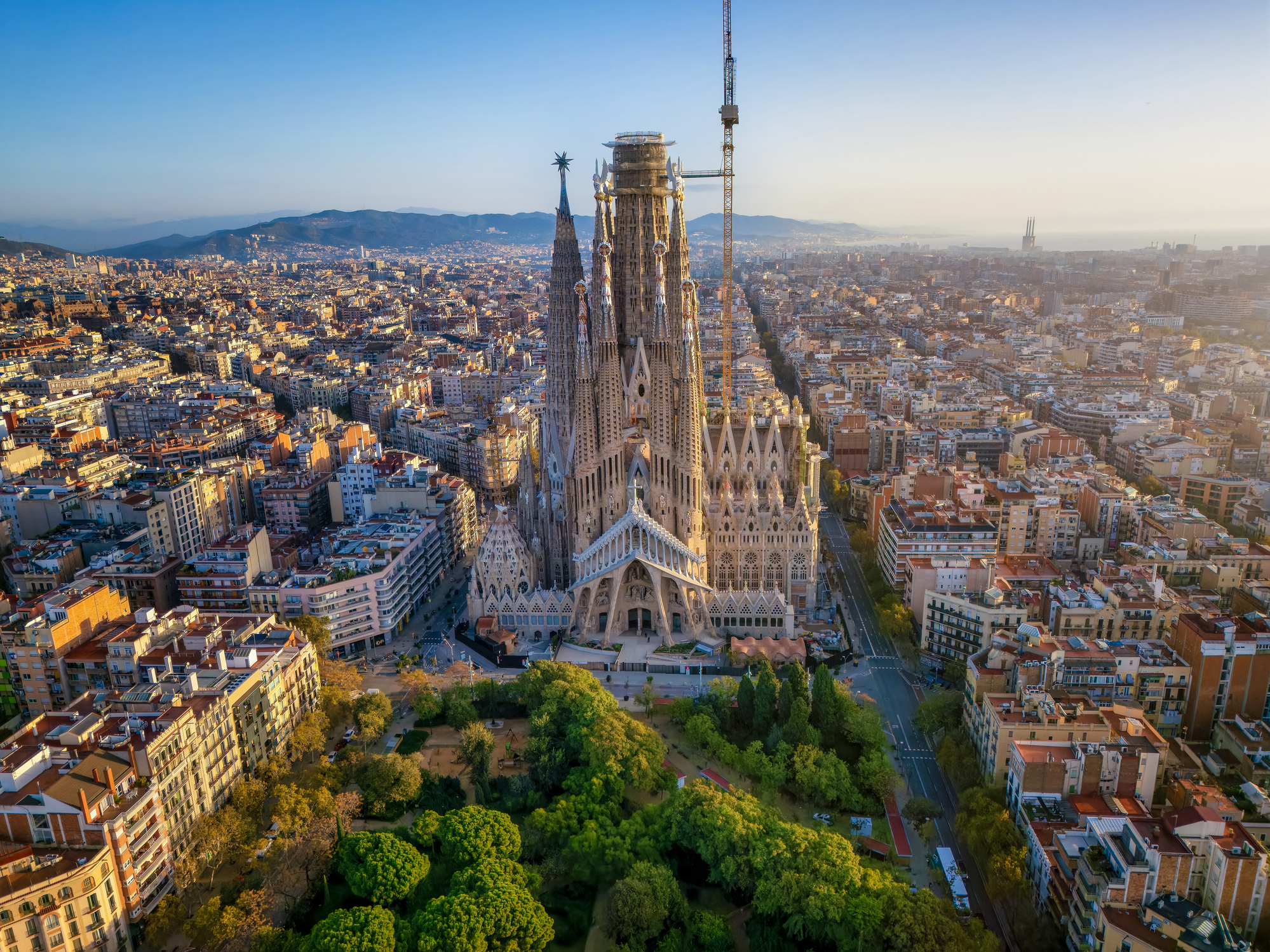
Mając reputację jednego z najatrakcyjniejszych miast w Europie, Barcelona świętuje swoją rolę stolicy Katalonii. Kosmopolityczna i międzynarodowa atmosfera miasta sprawia, że jest to ulubione miejsce wielu ludzi na całym świecie. Miasto jest szczególnie znane ze swojej architektury i sztuki – podróżnicy z całego świata przybywają, aby zobaczyć słynną Sagrada Familia i inne modernistyczne zabytki zaprojektowane przez Gaudiego.
Barcelona to miasto z licznymi i oryginalnymi możliwościami spędzania czasu wolnego, które sprawiają, że chcesz tu wracać. Położona na wybrzeżu Morza Śródziemnego Barcelona słynie z arcydzieł Gaudiego i architektury secesyjnej: jest jednym z najbardziej stylowych miast europejskich.
Miasto jest ośrodkiem nowych trendów w świecie kultury, mody i gastronomii. Dopełnieniem kreatywności artystów i projektantów jest ostrożne podejście do tradycyjnych placówek. Barcelona łączy w sobie urok i spokój historycznego centrum z awangardowymi nowoczesnymi dzielnicami i intensywnym tempem życia w jednym z najczęściej odwiedzanych miast na świecie.

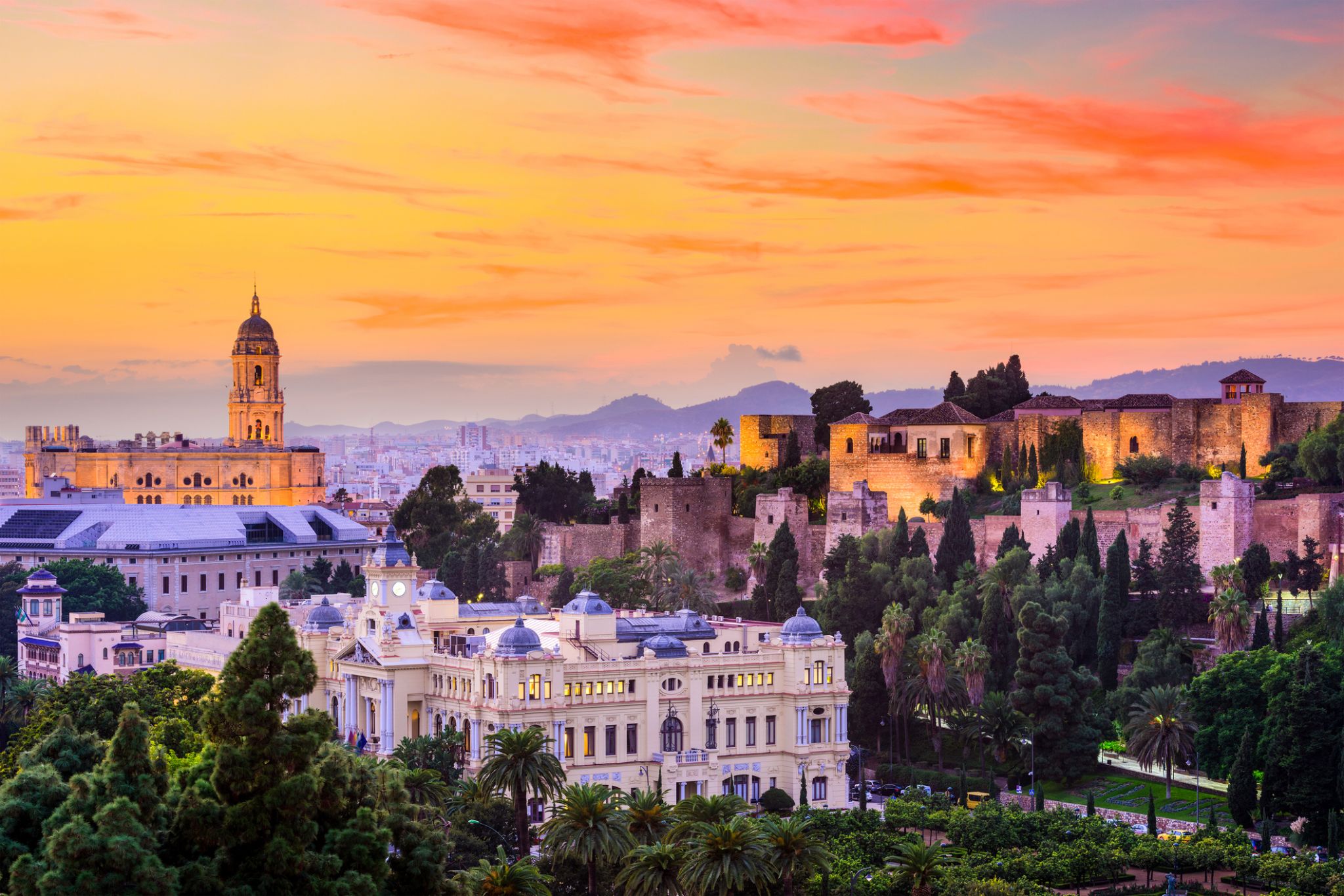
Málaga is a municipality, capital of the Province of Málaga, in the Autonomous Community of Andalusia, Spain. With a population of 569,130 in 2015, it is the second-most populous city of Andalusia and the sixth-largest in Spain. The southernmost large city in Europe, it lies on the Costa del Sol (Coast of the Sun) of the Mediterranean, about 100 kilometres (62.14 miles) east of the Strait of Gibraltar and about 130 km (80.78 mi) north of Africa.
Málaga's history spans about 2,800 years, making it one of the oldest cities in the world. According to most scholars, it was founded about 770 BC by the Phoenicians as Malaka From the 6th century BC the city was under the hegemony of Ancient Carthage, and from 218 BC, it was ruled by the Roman Republic and then empire as Malaca (Latin). After the fall of the empire and the end of Visigothic rule, it was under Islamic rule as Mālaqah for 800 years, but in 1487, the Crown of Castille gained control after the Reconquista. The archaeological remains and monuments from the Phoenician, Roman, Arabic and Christian eras make the historic center of the city an "open museum", displaying its history of nearly 3,000 years.
This important cultural infrastructure and the artistic heritage have culminated in the nomination of Málaga as a candidate for the 2016 European Capital of Culture.
The painter and sculptor Pablo Picasso, Hebrew poet and Jewish philosopher Solomon Ibn Gabirol and the actor Antonio Banderas were born in Málaga. The magnum opus of Cuban composer Ernesto Lecuona, "Malagueña", is named after the music of this region of Spain.
The most important business sectors in Málaga are tourism, construction and technology services, but other sectors such as transportation and logistics are beginning to expand. The Andalusia Technology Park (PTA), located in Málaga, has enjoyed significant growth since its inauguration in 1992. Málaga is the main economic and financial centre of southern Spain, home of the region's largest bank, Unicaja, and the fourth-ranking city in economic activity in Spain behind Madrid, Barcelona and Valencia.
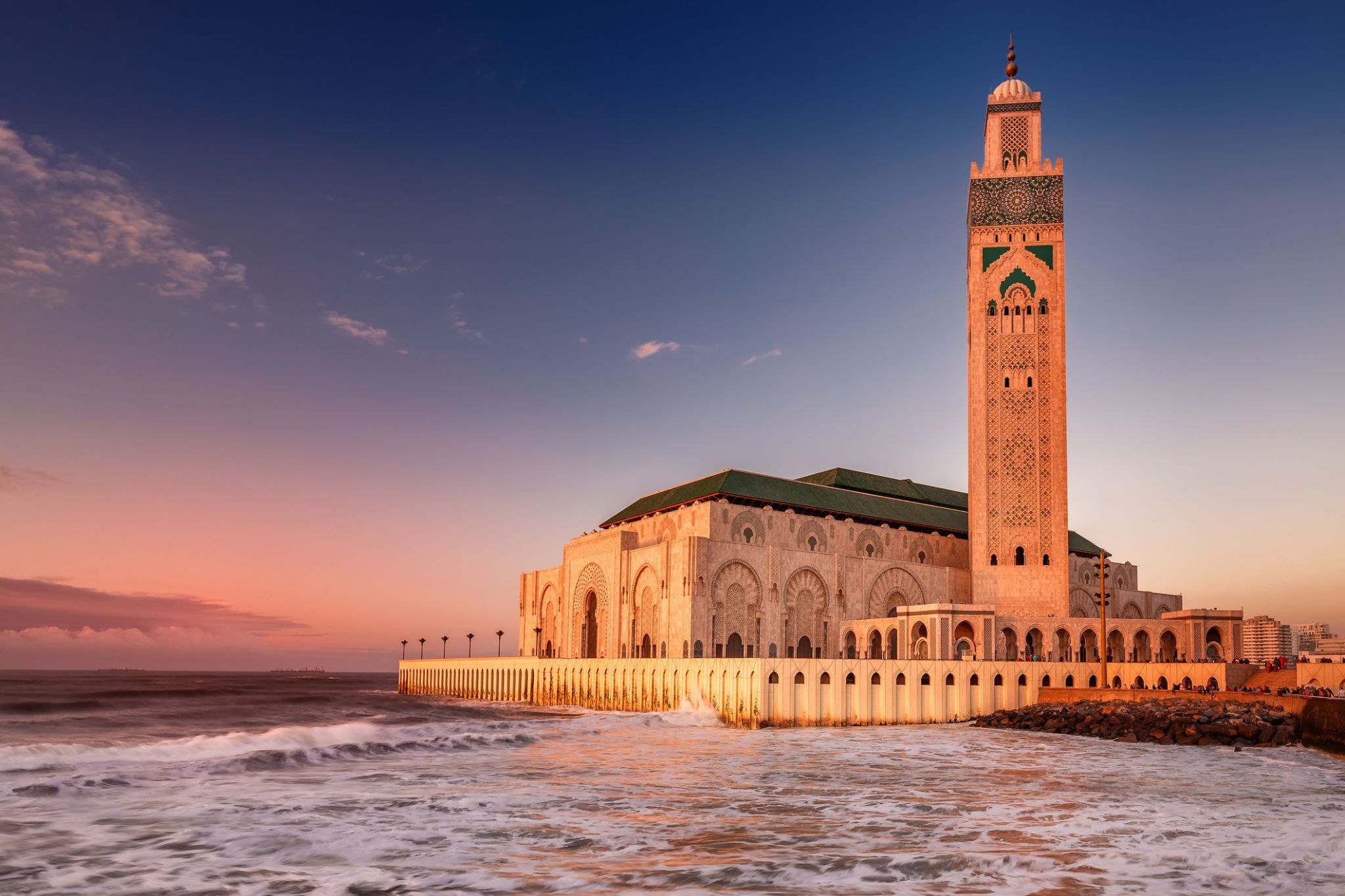
Casablanca położona jest w centralno-zachodniej części Maroka i graniczy z Oceanem Atlantyckim. Jest największym miastem Maroka. To także największe miasto regionu Maghrebu, a także jedno z największych i najważniejszych miast Afryki pod względem gospodarczym i demograficznym.
Casablanca jest głównym portem Maroka i jednym z największych centrów finansowych na kontynencie. Według szacunków z 2014 roku miasto liczy około 3,35 miliona mieszkańców na obszarze miejskim i ponad 6,8 miliona w regionie Casablanca-Settat. Casablanca uważana jest za gospodarcze i biznesowe centrum Maroka, podczas gdy polityczną stolicą kraju pozostaje Rabat.
Wiodące marokańskie firmy oraz liczne międzynarodowe korporacje działające w kraju mają swoje siedziby główne i główne zakłady przemysłowe w Casablanca. Najnowsze dane przemysłowe pokazują, że Casablanca zachowuje swoją historyczną rolę głównej strefy przemysłowej kraju. Port w Casablanca jest jednym z największych sztucznych portów na świecie i drugim co do wielkości portem w Afryce Północnej po Tanger-Med, 40 km na wschód od Tangeru. Casablanca jest także główną bazą morską Królewskiej Marynarki Wojennej Maroka.


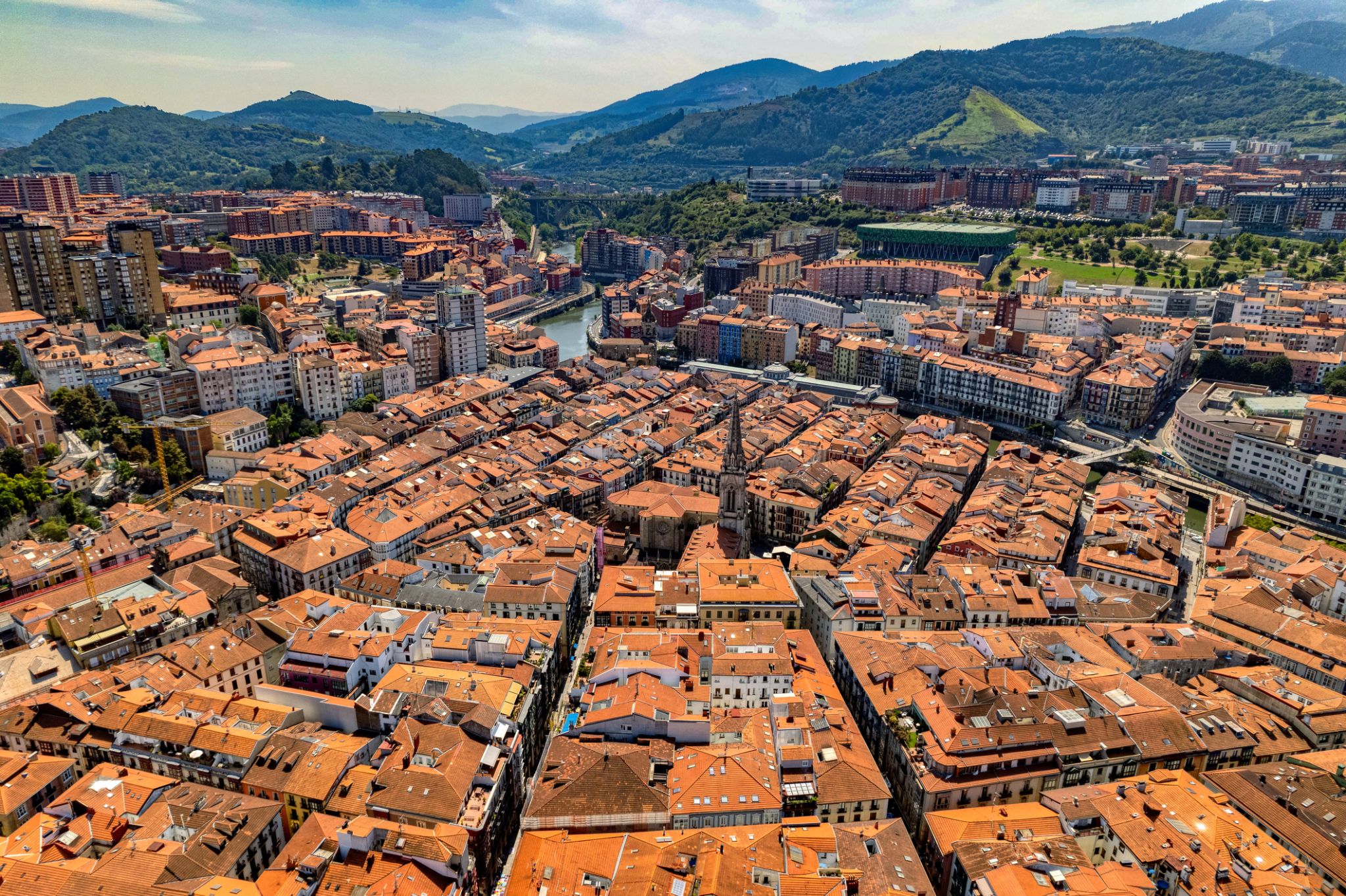
Bilbao is a city in northern Spain, the largest city in the province of Biscay and in the Basque Country as a whole. It is also the largest city proper in northern Spain. Bilbao is the tenth largest city in Spain, with a population of 345,141 as of 2015. The Bilbao metropolitan area has roughly 1 million inhabitants, making it one of the most populous metropolitan areas in northern Spain; with a population of 875,552 the comarca of Greater Bilbao is the fifth-largest urban area in Spain. Bilbao is also the main urban area in what is defined as the Greater Basque region.
Bilbao is situated in the north-central part of Spain, some 16 kilometres (10 mi) south of the Bay of Biscay, where the economic social development is located, where the estuary of Bilbao is formed. Its main urban core is surrounded by two small mountain ranges with an average elevation of 400 metres (1,300 ft). Its climate is shaped by the Bay of Biscay low-pressure systems and mild air, moderating summer temperatures by Iberian standards, with low sunshine and high rainfall. The annual temperature range is low for its latitude.
After its foundation in the early 14th century by Diego López V de Haro, head of the powerful Haro family, Bilbao was a commercial hub of the Basque Country that enjoyed significant importance in Green Spain. This was due to its port activity based on the export of iron extracted from the Biscayan quarries. Throughout the nineteenth century and the beginning of the twentieth, Bilbao experienced heavy industrialisation, making it the centre of the second-most industrialised region of Spain, behind Barcelona. At the same time an extraordinary population explosion prompted the annexation of several adjacent municipalities. Nowadays, Bilbao is a vigorous service city that is experiencing an ongoing social, economic, and aesthetic revitalisation process, started by the iconic Bilbao Guggenheim Museum, and continued by infrastructure investments, such as the airport terminal, the rapid transit system, the tram line, the Azkuna Zentroa, and the currently under development Abandoibarra and Zorrozaurrerenewal projects.
Bilbao is also home to football club Athletic Club de Bilbao, a significant symbol for Basque nationalism due to its promotion of only Basque players and one of the most successful clubs in Spanish football history.
On 19 May 2010, the city of Bilbao was recognised with the Lee Kuan Yew World City Prize, awarded by the city state of Singapore, in collaboration with the Swedish Nobel Academy. Considered the Nobel Prize for urbanism, it was handed out on 29 June 2010. On 7 January 2013, its mayor, Iñaki Azkuna, received the 2012 World Mayor Prize awarded every two years by the British foundation The City Mayors Foundation, in recognition of the urban transformation experienced by the Biscayan capital since the 1990s. On 8 November 2017, Bilbao was chosen the Best European City 2018 at The Urbanism Awards 2018, awarded by the international organisation The Academy of Urbanism.



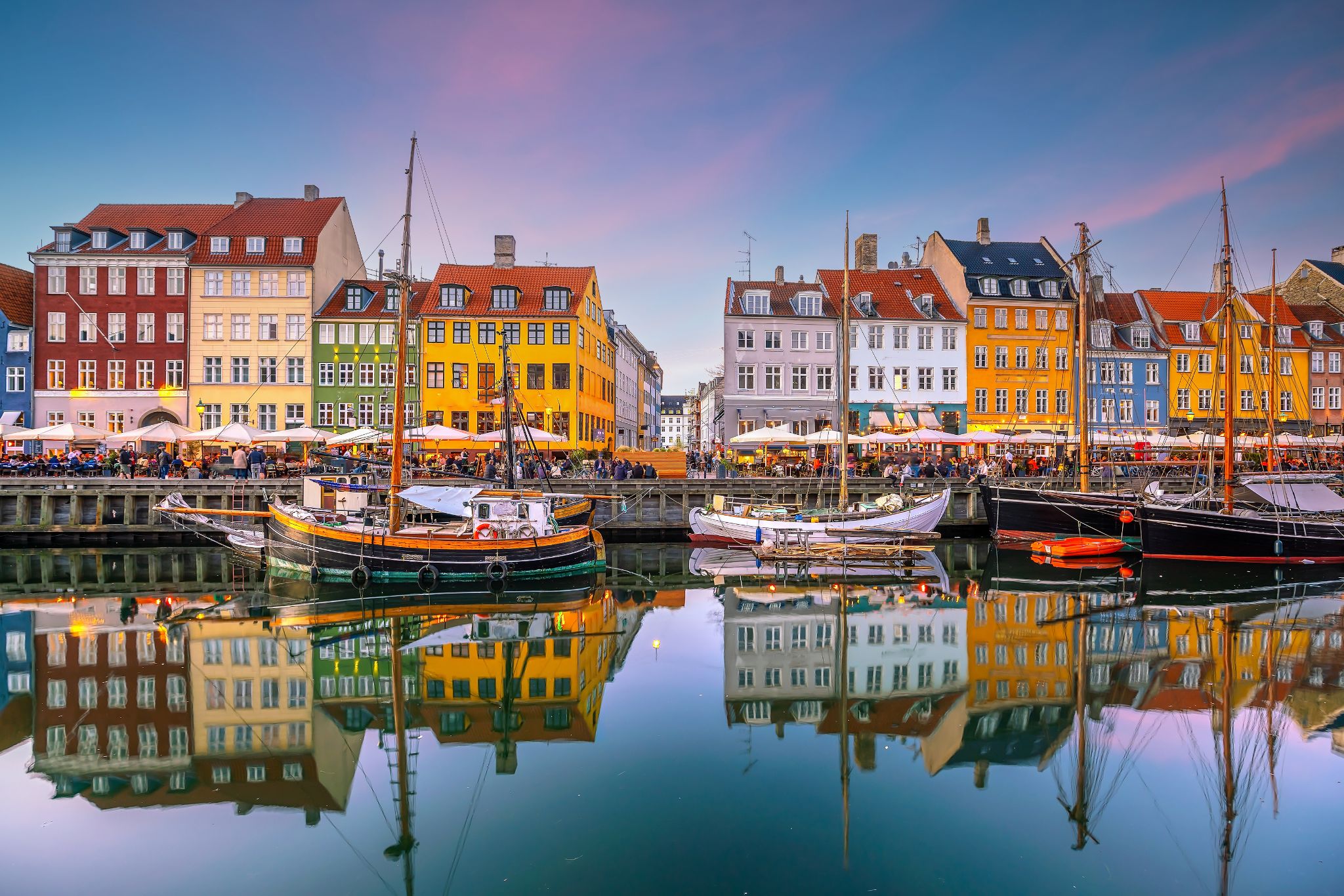
the capital and chief port of Denmark, a city that occupies the eastern part of Zealand and northern part of the island of Amager; population 518,574 (2009).